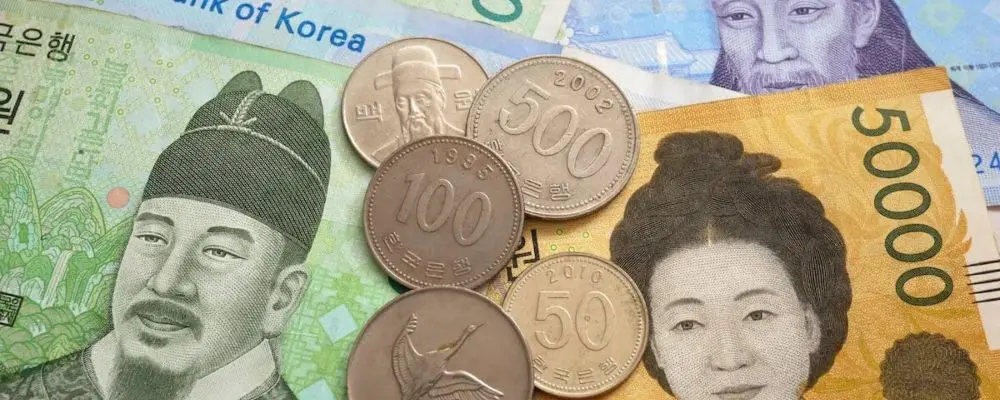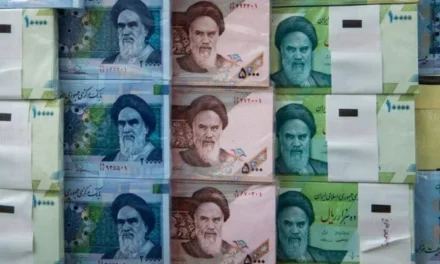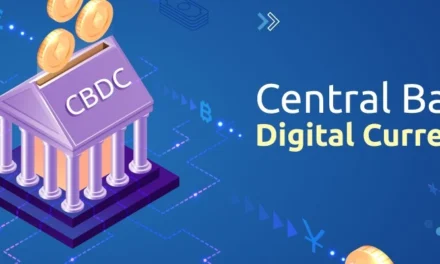The official currency of South Korea is the won (₩). It is issued by the Bank of Korea and is used by over 50 million people in the country. The history of the Korean currency dates back to the 10th century when the first coins were minted during the Goryeo Dynasty.
Discover the exchange rate, its history, the design of coins and banknotes, and much more. Keep reading!
Currency Exchange Rates
The South Korean won (KRW) is the official currency of South Korea. As with any currency, its value fluctuates against other currencies. The exchange rate is the value of one currency in relation to another.
- 1 USD = 1,288 KRW aprox.
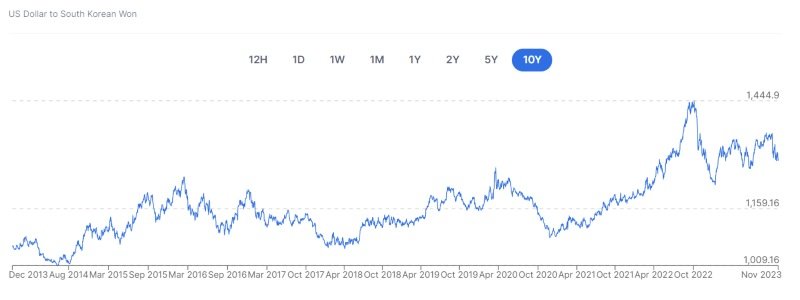
There are several factors that affect exchange rates, including economic and political conditions, interest rates, and inflation rates. As a result, exchange rates can change rapidly and unpredictably.
To stay up-to-date on the current exchange rate of KRW to other currencies, there are several resources available. One such resource is Xe, which provides real-time exchange rates for over 170 currencies.
Currency Design
The design of Korean currency is an important aspect of its cultural and historical significance. The Bank of Korea is responsible for designing and issuing banknotes and coins in the country.
Korean Banknotes
Korean banknotes feature various historical figures, landmarks, and cultural symbols. The current series of banknotes, issued in 2007, features the portrait of King Sejong the Great, who is known for his contributions to Korean culture and language.

Other notable figures on the banknotes include Admiral Yi Sun-sin, who is famous for his naval victories against Japan in the late 16th century, and the poet Yun Seon-do.
The banknotes also feature various cultural symbols, such as the Gyeonghoeru Pavilion, which was used for royal banquets during the Joseon Dynasty, and the turtle ship, which was a type of warship used by Admiral Yi Sun-sin.
Korean Coins
Korean coins also feature various cultural symbols and historical figures. The most commonly used coins are the 10 won, 50 won, 100 won, and 500 won coins.
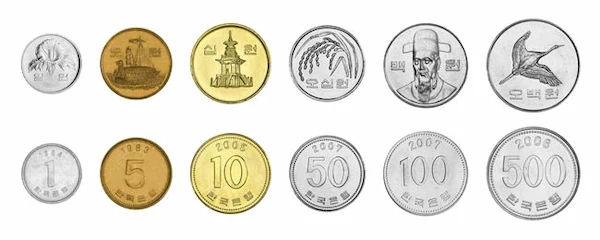
- The 10 won coin features the image of a flower.
- The 50 won coin features the image of a bird.
- The 100 won coin features the image of Admiral Yi Sun-sin.
- The 500 won coin features the image of King Sejong the Great.
In addition to the cultural symbols, the coins also feature the Korean alphabet, known as Hangul, which was invented by King Sejong the Great. The Hangul characters on the coins spell out the denomination of the coin.
History of Korean Currency
- Prehistoric Era
The history of Korean currency dates back to around the 3rd century BC during the prehistoric era when knife coins, also known as “Myeongdojun,” were circulated in the state of Yan and Gojoseon.
These coins were made of bronze and were in the shape of knives. The knife coins were used as a medium of exchange for the purchase of goods and services.
- Three Kingdoms Period
During the Three Kingdoms period (57 BC – 668 AD), the use of coins as currency became more widespread. The coins were made of bronze and had a round shape with a square hole in the center.
These coins were called “Byeongjin” and were used in the kingdoms of Goguryeo, Baekje, and Silla.
- Goryeo Dynasty
During the Goryeo dynasty (918-1392), the first coins were minted. The coins, cast in both bronze and iron, were called “tongbo” and “jungbo”.
Additionally, silver vases called “ŭnbyŏng” were widely used and circulated as a currency among the aristocracy of Goryeo.
- Joseon Dynasty
In the Joseon dynasty (1392-1910), the use of coins became more widespread, and the government started to issue paper money called “joseonpil” in the late 14th century.
The paper money was initially used for military expenses and was later used as a medium of exchange for commerce. The Joseon dynasty also introduced a new coin called “mun” in the late 17th century, which was made of copper and had a square hole in the center.
- Modern Era
In the modern era, the Korean won was introduced in 1902 during the Japanese occupation of Korea. The Korean won was replaced by the Japanese yen in 1910 and was reintroduced in 1945 after the liberation of Korea from Japan.
The South Korean won was issued in 1949, and the North Korean won was issued in 1947. Today, the South Korean won is the official currency of South Korea, and the North Korean won is the official currency of North Korea.
Future of Korean Currency
The future of the Korean currency looks promising, as the country is expected to maintain its economic growth and stability. According to CEIC Data, the exchange rate of the Korean won against the US dollar is projected to increase from 1,317.495 USD/KRW in 2023 to 1,320.815 USD/KRW in 2024. This indicates that the Korean currency is likely to appreciate in value against the US dollar in the coming years.
Moreover, the South Korean won has been performing well against other Asian currencies, as reported by Bloomberg. The article suggests that the Korean won is expected to maintain its lead as the best-performing Asian currency in the current quarter, ahead of the Thai baht and other major currencies in the region.
The Korean government has also been taking measures to strengthen the country’s economy and currency. For instance, the government has been promoting exports and investing in infrastructure development to boost economic growth. Additionally, the Bank of Korea has been maintaining a stable monetary policy to ensure price stability and support economic growth.
Impact of Korean Currency on Economy
The Korean currency, also known as the won, plays a crucial role in the country’s economy. The exchange rate of the won against other currencies affects various aspects of the economy, including trade, investment, inflation, and growth.
When the won is weaker against other currencies, Korean exports become more competitive, which can boost the country’s trade surplus. On the other hand, a stronger won can make exports more expensive, leading to a trade deficit.
According to CME Group, the Korean won has been trading within a relatively narrow 20% range against the US dollar since 2010. Currently, it is almost exactly in the middle of that range.
The exchange rate also affects foreign investment in Korea. A weaker won can make Korean assets more attractive to foreign investors, leading to more inflows of foreign capital. Conversely, a stronger won can discourage foreign investment. However, a weaker won can also lead to higher inflation, which can negatively impact the economy.
In recent years, the Korean won has faced headwinds due to various factors, including weak exports, the COVID-19 pandemic, and global economic uncertainty. As S&P Global reports, the South Korean economy slowed significantly during the second half of 2022, with GDP contracting by 0.4% quarter-on-quarter in the fourth quarter of 2022. The country is expected to face continuing economic headwinds in 2023-2024 due to the impact of weak exports and the cumulative effects of the pandemic.
Overall, the Korean currency has a significant impact on the country’s economy, affecting trade, investment, inflation, and growth. The government and central bank closely monitor the exchange rate and take measures to stabilize the won when necessary.
Frequently Asked Questions
What is the current exchange rate for Korean Won to US Dollars?
As of the current date, the exchange rate for Korean Won to US Dollars is not available. However, the exchange rate is subject to change based on market fluctuations and other factors.
It is recommended to check with a reputable financial institution or currency exchange service for the most up-to-date information.
What is the equivalent value of 1000 Korean Won in Indian Rupees?
As of the current date, the equivalent value of 1000 Korean Won in Indian Rupees is 64,50 aprox.
The exchange rate between the Korean Won and Indian Rupees is subject to change based on market fluctuations and other factors. It is recommended to check with a reputable financial institution or currency exchange service for the most up-to-date information.
What is the name of the currency used in South Korea?
The currency used in South Korea is the South Korean Won (KRW). It is issued and regulated by the Bank of Korea, which has been in operation since 1950.
What is the current exchange rate for South Korean Won to GBP?
As of the current date, the exchange rate for South Korean Won to GBP is: 1 GBP = 1637
How do I convert Korean currency to Peso?
To convert Korean currency to Peso, you can use a currency converter tool like this one, which is available online or through a financial institution. Simply enter the amount of Korean currency you wish to convert and select the Peso as the desired currency. The converter will provide you with the current exchange rate and the equivalent value in Peso.
What is the current value of $1 US in Korean Won?
As of the current date, the current value of $1 US in Korean Won is 1291

